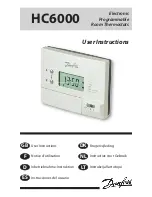
2800 Laura Lane Madison, WI 53562 | 800.288.9383 Fax: 608.836.9044 | www.tcsbasys.com
24
System Test screen details vary pending on model specific features.
Relay Outputs
: The square toggle buttons at the top of the screen allow direct manipulation of the relays. When the
button is highlighted, the relay is active, and the connected equipment should turn on. After a relay button is touched,
there is a 3 second delay before the changes apply. Turning on a heating or cooling relay also turns on the fan relay [G]
as equipment safety precaution. The fan relay can be turned off subsequently. If toggled off within the three second
delay the fan will not turn on.
Analog Outputs
: The con
fi
guration of each analog output is identi
fi
ed on the screen. Each analog output can be ad-
justed up or down in 10% increments. The percentage output corresponds to the amount of heating or cooling desired.
The mA output shows the actual signal being sent, taking into account reverse/direct action and 0/4-20mA range.
Control Testing
: The Control Testing buttons simulate a large need for heating or cooling, and allows the controller
to manipulate the respective outputs. During this process, all programed sequencing and delays are in effect. The
heat/cool lockout logic is disabled during this testing in order to allow the heating and cooling to be tested in
any season, however, the discharge air limits are allowed to operate as this is part of the testing. A heating or cooling
test runs for ten minutes (unless canceled), with a countdown timer shown. Also, the affected analog outputs
are driven immediately to the appropriate Max/Min levels. When a test is active the manual control of relays and
analog outputs is disabled. However, the state of each relay is still reflected by its button’s toggle (highlighted) state.
While control testing is in progress, the inputs can be monitored to verify correct equipment operation.
Controller Inputs
: Located on the bottom half of the screen, the inputs are updated once a second. They are useful
for monitoring the test in progress, and are broken into three groups:
• Temperature
Sensors
: Temperature readings as well as Ohms for T1, T2, T3, and the internal sensor are shown.
For troubleshooting purposes the RTD inputs report both open circuit and shorted circuit conditions. An open
circuit means there is likely either no sensor connected, a broken wire, or the sensor is reporting a value above
the range of the input. A short circuit means wires are shorted together, or the sensor is reporting a value
below the input range.
• Digital Inputs (DI)
: Shown is whether the DI is sensing open or closed contacts as well as how the state is
interpreted internally (active or inactive). Typically, active refers to a closed contact and inactive refer to open
contact (when polarity is normal).
• Analog Inputs (AI)
: The value is shown as being scaled to engineering units as well as the raw milliamperage.
4.5.2.11 Access Code
This access code, if enabled, prevents unauthorized access to all setting screens. By default, the access code is
disabled. The access code consists of four digits; the access code “0000” disables the access code feature. If you have
lost or forgotten your code please call TCS Tech Support.
4.5.3 Expert Settings
By default, the UbiquiSTAT
™
ships with two stages of heat and two stages of cool enabled (based on model feature
availability). Each stage may be independently disabled in order to prevent it from being considered by the control logic.
This can be useful if, for example, the connected equipment does not support the stages, or to correct for a wiring error.
Stages can be enabled and disabled using the internal BACnet explorer screen. Each stage has an object that can be
configured to enable or disable the given stage.
See the object list in Appendix A
.
4.5.3.2 Configuring Additional Stages
When configured as a conventional thermostat type, the B/O and TC relays may be used as third and/or fourth stages of
heating and/or cooling (based on model feature availability). In order to make these relays available as additional stages,
the corresponding relay mode object must be configured appropriately. For example, to configure the B/O relay as a third
stage of heat, configure the “B/O Mode” (MSV-316) to the value “Heat Stage 3”.
4.5.3.3 Con
fi
guring Analog Input Scaling
The analog inputs (AI1 and AI2) always measure a signal in milliamps. The raw milliamp reading can be scaled into
any units desired in order to properly re
fl
ect the sensor measurement (engineering units). The scaling is con
fi
gured
independently for each analog input using the following BACnet objects (AIx represents AI1 or AI2):
USER
INTERFACE
















































